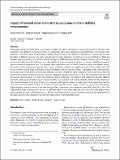Impact of tailored water chemistry aqueous ions on foam stability enhancement
Author(s)
AlYousef, Zuhair; Ayirala, Subhash; Almubarak, Majed; Cha, Dongkyu
Download13202_2021_Article_1216.pdf (960.0Kb)
Publisher with Creative Commons License
Publisher with Creative Commons License
Creative Commons Attribution
Terms of use
Metadata
Show full item recordAbstract
Abstract
Generating strong and stable foam is necessary to achieve in-depth conformance control in the reservoir. Besides other parameters, the chemistry of injection water can significantly impact foam generation and stabilization. The tailored water chemistry was found to have good potential to improve foam stability. The objective of this study is to extensively evaluate the effect of different aqueous ions in the selected tailored water chemistry formulations on foam stabilization. Bulk and dynamic foam experiments were used to evaluate the impact of different tailored water chemistry aqueous ions on foam generation and stabilization. For bulk foam tests, the stability of foams generated using three surfactants and different aqueous ions was analyzed using bottle tests. For dynamic foam experiments, the tests were conducted using a microfluidic device. The results clearly demonstrated that the ionic content of aqueous solutions can significantly affect foam stabilization. The results revealed that the foam stabilization in bulk is different than that in porous media. Depending on the surfactant type, the divalent ions were found to have stronger influence on foam stabilization when compared to monovalent ions. The bulk foam results pointed out that the aqueous solutions containing calcium chloride salt (CaCl2) showed longer foam life with the anionic surfactant and very weak foam with the nonionic surfactant. The solutions with magnesium chloride (MgCl2) and CaCl2 salts displayed higher impact on foam stability in comparison with sodium chloride (NaCl) with the amphoteric alkyl amine surfactant. Less stable foams were generated with aqueous solutions comprising of both magnesium and calcium ions. In the microfluidic model, the solutions containing MgCl2 showed higher resistance to gas flow and subsequently higher mobility reduction factor for the injection gas when compared to those produced using NaCl and CaCl2 salts. This experimental study focusing about the role of different aqueous ions in the injection water on foam could help in better understanding the foam stabilization process. The new knowledge gained can also enable the selection and optimization of the right injection water chemistry and suitable chemicals for foam field applications.
Date issued
2021-07-19Department
Massachusetts Institute of Technology. Department of Civil and Environmental EngineeringPublisher
Springer International Publishing